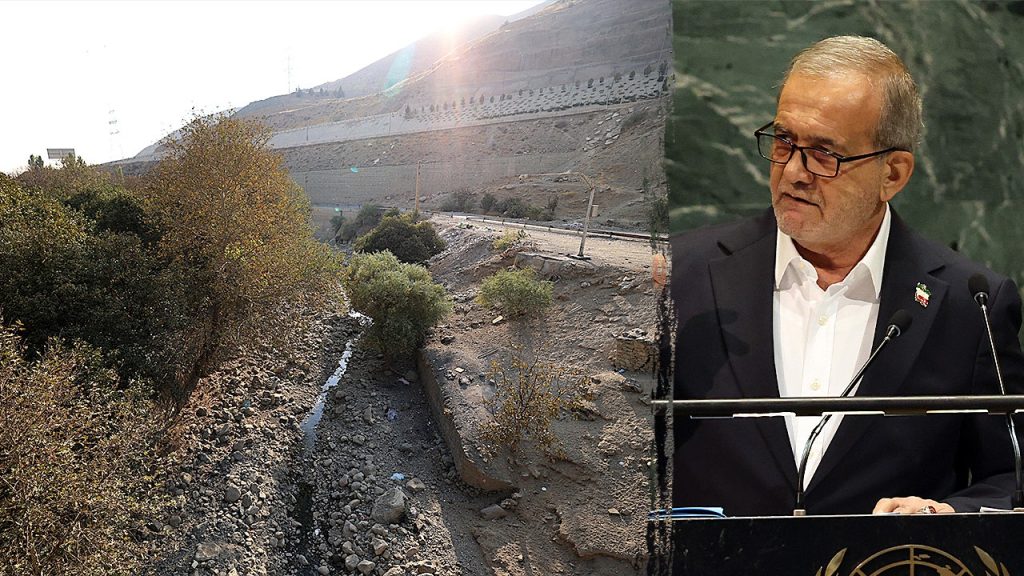Iran’s Worsening Water Crisis Threatens Stability, Nuclear Ambitions, and Daily Life
Iran is facing what experts call its most severe drought in decades, creating a national water crisis that threatens not just the everyday lives of citizens but the very foundations of the regime’s stability and global standing. According to Kaveh Madani, Director of the United Nations University Institute for Water, Environment and Health, the country has entered a state of “water bankruptcy” that was decades in the making. “The water bankruptcy situation was not created overnight,” Madani explained. “The house was already on fire, and people like myself had warned the government for years that this situation would emerge.” This slow-moving environmental disaster now poses an existential challenge to Iran, as the symptoms that were once easily ignored have evolved into undeniable threats to basic infrastructure, particularly in Tehran, where millions face the prospect of water rationing and potential disruptions to daily life.
The situation in Tehran has become particularly alarming, with President Masoud Pezeshkian warning that without significant rainfall before winter, parts of the capital might require evacuation—an unprecedented measure for a modern metropolis of its size. The water infrastructure supporting the city of nearly 9 million people is showing critical signs of failure: of the five major dams supplying Tehran, one has completely dried up, while another is operating at less than 8% capacity. Energy Minister Abbas Alibadi has already announced evening water cutoffs to refill reservoirs and urged citizens to reduce their consumption by 20% to avoid more severe rationing measures. “We are discussing Day Zero, when the taps would run dry in Tehran and other cities once immune to shortages,” Madani warned, highlighting the immediacy of a crisis that can no longer be downplayed or postponed through short-term solutions.
This water crisis represents more than just an environmental challenge—it strikes at the heart of Iran’s national security and political stability. When basic necessities like water and electricity become unreliable, public frustration can quickly transform into widespread unrest, creating vulnerabilities that even Iran’s most committed adversaries couldn’t engineer. “When people are out of water and electricity, you face domestic and national security problems that even Iran’s enemies, not even President Trump or Prime Minister Netanyahu, could have wished for,” Madani observed. The Iranian government now faces a delicate balancing act: addressing immediate humanitarian needs while maintaining its posture of resistance against international pressure. This crisis comes at a particularly sensitive time, as Iran continues to face international isolation and sanctions affecting its economic resilience and ability to import necessary resources and technology.
The water shortage also threatens Iran’s energy infrastructure and nuclear ambitions, creating a cascade of challenges for a regime already struggling under the weight of international sanctions. Reduced rainfall means diminished hydroelectric power generation, contributing to both water shortages and electricity blackouts across the country. According to Madani, “If water and electricity shortages persist, any nuclear program would also be impacted.” This connection between water scarcity and national power highlights how environmental challenges can directly affect geopolitical positioning. Despite recent reports suggesting ongoing uranium enrichment at fortified sites like “Pickaxe Mountain,” the practical operation of such facilities requires reliable water and energy supplies—resources that are increasingly strained by the current crisis. The drought thus undermines not only daily life for ordinary Iranians but also the strategic capabilities the regime has prioritized in its confrontation with Western powers.
International sanctions have complicated Iran’s ability to respond effectively to the water crisis. Since the collapse of the 2015 nuclear deal, the United States and its allies have reimposed sweeping sanctions on Iran’s oil exports and banking sector, limiting the country’s access to international markets and technology that might help address water management challenges. “Iran is in resistance mode, and remaining in this mode means increased pressure on Iran’s ecosystem, natural resources, and water, but it also means heightened concerns about food insecurity issues and dependence on food imports,” Madani explained. This creates a dangerous feedback loop: as sanctions pressure the regime to prioritize self-sufficiency and resistance, the resulting strain on natural resources worsens environmental degradation, further weakening Iran’s position. “This water bankruptcy weakens Iran on the world stage,” Madani noted. “If they want to stick to their ideology and fight with the West, they must use their natural resources and burn them, so if there is no water, there is less resilience and less capacity to resist.”
Despite the dire warnings about potential evacuations, Madani believes a mass exodus from Tehran remains unlikely in the immediate future. “People have jobs, children are in school, so it can’t happen overnight. The government hopes for rain, but people are already afraid,” he said. The practical realities of relocating millions of people from the nation’s capital present logistical challenges that would overwhelm even the most organized government response. Instead, Iranians are likely to face increasing water rationing, scheduled outages, and deteriorating quality of life as authorities struggle to manage dwindling resources. The crisis represents a profound test for the new administration under President Pezeshkian, who must balance immediate humanitarian needs against long-term sustainability while maintaining political stability. While the government publicly places its hopes on rainfall to alleviate the crisis, the underlying issues of decades of mismanagement, climate change impacts, and unsustainable water practices will require far more comprehensive solutions to prevent similar crises in the future.


